Learn the Role of User Interface (UI) Design in 3D Games at Arena Multimedia, SAIT
In the world of 3D game development, user interface (UI) design plays a critical role in enhancing player experience and immersion. UI design...
4 min read
 Admin
:
Mar 30, 2023 7:43:14 PM
Admin
:
Mar 30, 2023 7:43:14 PM

Graphic Design
Graphic design is a broad field with many forms: you can be a graphic designer and design books and logos, or you can design web interfaces, T-shirts, chocolate boxes, or political posters. However, all these specialized areas of design have a common purpose. The design has been used to represent a product, an idea, or a message and convey that to an audience. Graphic design is a way of communicating something to someone else through visual means. The building blocks of graphic design are words and pictures. They are everywhere (quite literally). As graphic design elements become more prevalent in our lives, graphic design practices become more important in our culture, and there is an increase in the need for more graphic designers. There are many different types of graphic designers. Some are very technical, and some are very formal. Some designers' practices are derived from research or concept, some are purely style and aesthetics, and others from the desire to experiment. All these designers deal with controlled communication with Text and Image. Sometimes designers use just images (illustration), or sometimes they use text (typography). But most designers use a combination of the two (Text and Images), tied together using color and composition.
At the Centre for Design Studies, SAIT, Indore, we introduce this (Graphic Design) vast and varied practice down to some fundamental skills. The foundation courses for B.Des. students are the building blocks that students need to master to be able to eventually build something complex and refined. The understanding that they gain here is going to be relevant to every specialized area of graphic design. In our CDS foundation courses, we start breaking down a graphic design into its basic components: Image, Type, Shape, and Color. Then we look at the composition, where all the elements come together into a composite piece of graphic design. By breaking the larger practice of graphic design down into smaller areas, we examine how each of them works, and students learn about them in greater depth. One of the best ways to do that is by practicing it and feeling excited about making something with your hands.
At the Centre for Design Studies, SAIT, Indore, the Foundation course in graphic design mainly focuses on hands-on activity in the BDes. first-year courses, which are practical in nature. We believe that if one wants to be a designer, he/she must be a visual person and a maker. A maker of meaning, or a maker of form, or preferably both. At the Centre for Design Studies, SAIT, our aim is that by the end of this course, students will ‘taste’ the core aspects that make up the practice of graphic design. In our courses, students experiment with image-making, try to handle typography, and learn about color, shapes, and composition. With a variety of creative tasks, students acquire an appetite to develop those skills and a desire to continue to build their skills with the ultimate goal of becoming successful graphic designers.
Image Making in Graphic Design
Denotative Images
The Methods and Material course at CDS, SAIT explores image-making techniques. Graphic design practices involve image making and these images often work as literal depictions: ‘the image represents itself’. We call these images ‘Denotative Images’. For instance, let's say we are making an image of a Papaya, it sounds simple but, how that Papaya is represented can say a lot about the Papaya to the viewer. The technique which is used to make an image and the aesthetics of the image can say a lot about the Papaya. The texture gives different information about the same object/thing. So, how the image is made becomes very important, the designed image says a lot about the actual object. For example, our CDS Student Shruti Maheshwari has selected Papaya as her subject and represented it using varieties of mediums like watercolours, oil pastels, café, seeds etc. Shruti said, “the whole experience was very interesting I tried some conventional and unconventional materials to depict my subject (Papaya).”
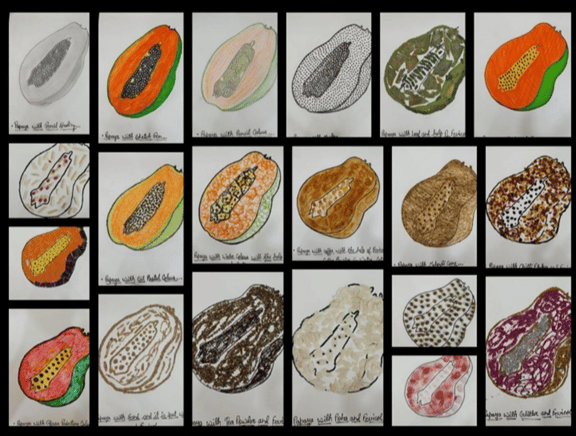
Representation of Papaya in various mediums by Shruti Maheshwari
Similarly, another CDS Student Rashida Latthawala used interesting materials to depict a ‘Cup’. While explaining about her image-making process said, “as you can see in the below image some mediums helped me to shout the gloss effect and some mediums have not, with this experiment I have learnt about affordance of materials.”
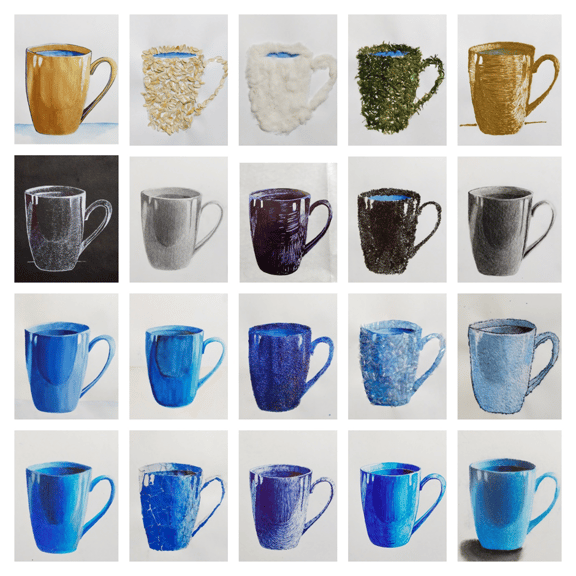
Representation of Cup in various mediums by Rashida Latthawala
As one can see through these design experiments students are adding some extra information to the object and communicating that extra information to the viewer. This can have a big effect; in this case, it might make the difference between whether you want to eat the Papaya or not.
Connotative Images
It gets more complicated when we change that denotative or archetype image and pair that image with other elements. When students do this, the object (Cup, Papaya, bulb) no longer remains the same. It can represent or suggest different ideas. These kinds of images are called ‘Connotative Images.’ For instance, if we put a test grade on an apple, then the apple becomes about knowledge. If we put a few lines indicating the fall of an apple, we can read that apple is about gravity. One-half red and one-half green can be about good and evil, or a snake wrapped around an apple can be about sin or temptation.
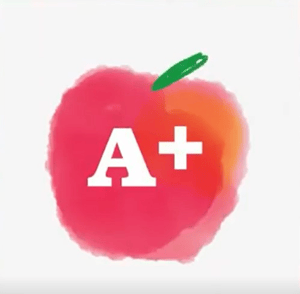
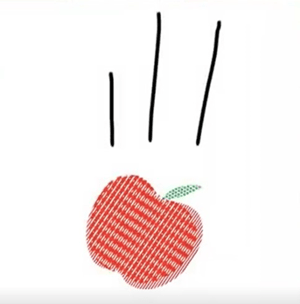
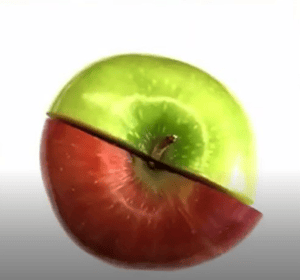
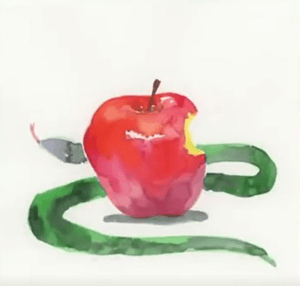
Connotative Representation of Apple
In our CDS, SAIT B. Design foundation courses like Theory and Practice, we make images that are literal and metaphorical. Images that are denotative and connotative. Students experiment with different image-making techniques and materials, and are encouraged to take risks and be innovative. They learn how to visually communicate ideas and messages, and how to create meaning through their designs.
Conclusion
Graphic design is an important and exciting field that encompasses many different forms and practices. At Centre for Design Studies, SAIT, we introduce students to the fundamental skills and concepts of graphic design through hands-on activities and practical projects. We believe that by learning how to create images and designs, students develop important visual and communication skills that are relevant to many different areas of their lives. Whether they go on to become professional graphic designers, or simply use these skills in their personal lives, we hope that our students will leave our courses with a deeper understanding and appreciation of the power of graphic design.
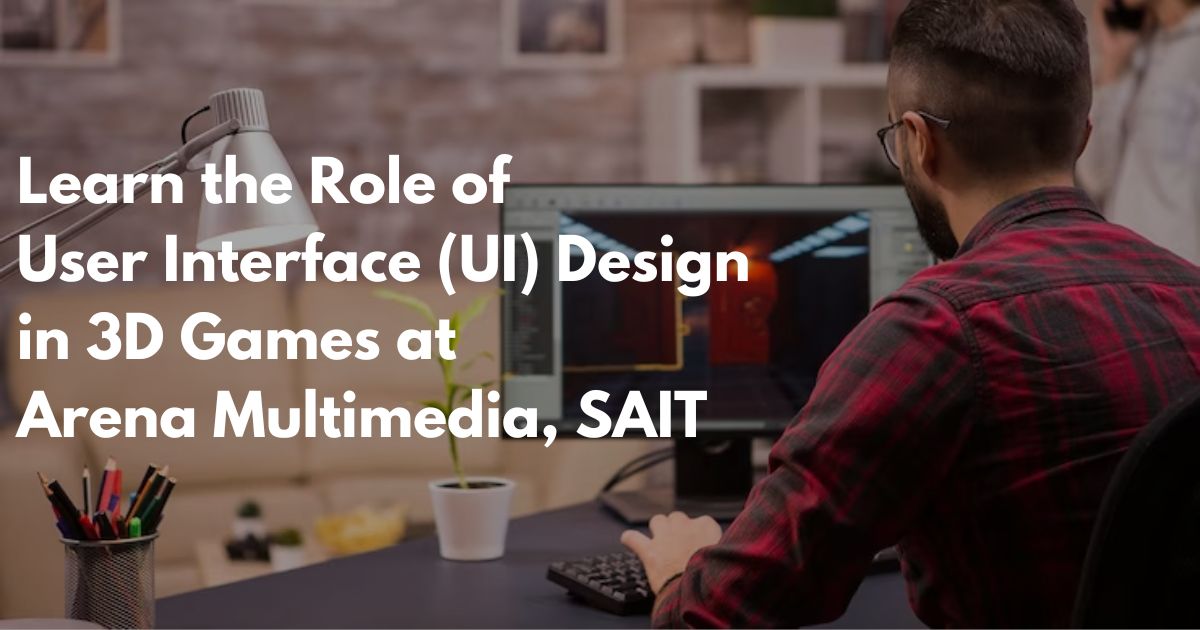
In the world of 3D game development, user interface (UI) design plays a critical role in enhancing player experience and immersion. UI design...

As a designer, you know that the industry is constantly changing and evolving. To stay relevant and competitive, it's important to make connections...

Are you interested in pursuing a career in animation, VFX, graphics design, digital advertising design, marketing, web design and development, UI-UX,...